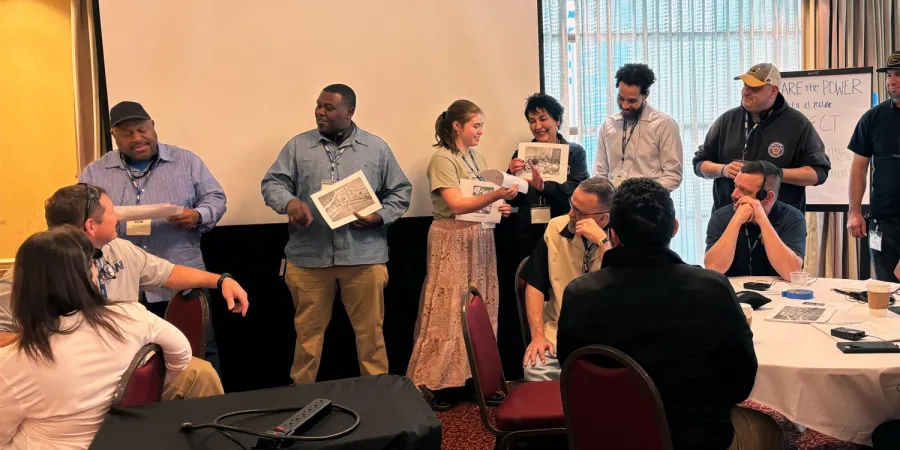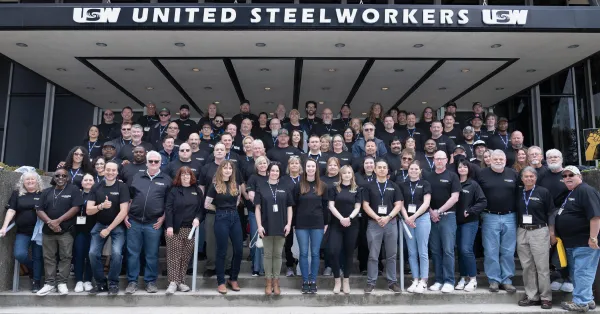TMC Trainers' Enhancement Exchange

The 2024 TEE took place in Pittsburgh last month. Check out the highlights from the event here!
The United Steelworkers (USW) Tony Mazzocchi Center (TMC) hosted over 90 Steelworker members, immigrant worker representatives and tribe members at their 2024 Trainers’ Enhancement Exchange (TEE) in Pittsburgh, Pa., April 22-26. Workers came from all over the United States and Puerto Rico to attend the conference. The yearly trainers’ exchange is designed for trainers to share best practices and new techniques through a series of workshops conducted by the staff and trainers themselves. The goals are to meet and share ideas about how to create more effective and empowering training, improve training skills, and exchange best practices and techniques.
Attendees participated in daily interactive plenary sessions followed by two-hour workshops. The topics on Monday included Public Speaking and Team Building, two essential skills for trainers. Working alongside people from different industrial sectors, regions and cultures, allows TMC worker-trainers to better understand broad patterns in workplace conditions across the country.
The day began with activities designed to teach trainers the value of playing games during training sessions. While emphasizing the need for health and safety trainees to bond, the session itself served as an excellent ice breaker for all present.
Tuesday shifted the focus to Language Justice, led by immigrant worker center, Specialized Emergency Response Trainers (SERTs) and bilingual Department of Energy (DOE) trainers. The workshop (as with all TEE workshops) was conducted in both English and Spanish. All attendees were equipped with headsets for simultaneous translation.
Most attendees anticipated the workshop to revolve around different languages; however, they were surprised when the workshop began by delving into “verbality,” the proficiency in spoken and auditory skills.
Nuclear facilities worker-trainer, Page Cisco, of USW Local Union 1-689, expressed her satisfaction with the workshop’s focus on verbality, mentioning that she had been learning sign language due to her interaction with a young relative who required a combination of spoken and sign language. Sister Cisco emphasized, “there are many individuals in our workplaces - more than we might realize - with needs we need to be aware of.”
Numerous workshop participants expressed their willingness to enroll in Spanish lessons if provided by the TMC. Bryan Nystrom (DOE trainer, USW Local 8-550, Paducah, Ky.) added, “for sure, I would take a course; everybody needs to have each other’s back.”
Nathan Yount, an oil sector worker from Anacortes, Wash., commented that the TMC might consider designing a survey to identify special language needs. Nathan suggested that color codes might be used at workstations to alert people of communication needs. He also remarked that courses in English might be provided by the union, “it’s not only fair, but our safety also depends on it.”
Yount also belongs to a site that participates in the USW Triangle of Prevention, or TOP, program facilitated by the USWTMC.

Later in the day, TMC worker-trainers addressed a topic not talked about enough: The Aging Workforce. As with all TMC-lead training sessions, the workshop trainers introduced the topic, but it was the participants themselves that shaped the discussion. People talked openly about the various challenges that older workers face, like decreasing resistance to bodily stresses, such as heat, cold, weight, and speed. The workshop stressed how union-led health and safety awareness at all job sites can help mitigate these challenges. But also, the conversation turned toward the net positive of having more experienced workers actively engage younger workers. Statistics show that young workers are more at risk for serious injury on the job.
Another groundbreaking topic the TMC faced head on was the issue of Women’s Personal Protective Equipment (PPE). Participants related their personal experiences with PPE and had ample opportunity to try on a wide variety of personal protective equipment devices. This hands-on approach is optimal in that it conjoins audial, visual and tactile learning methods.
Diversity and Inclusion capped off the day. Though it should go without saying that the USW and its partner organizations are wholly committed to representing every single member regardless of age, sex and race. Still though, our USW trainers added some crucial insights to widen and sharpen our awareness of diversity. And it was done USW style! Everything flowed from and toward maximum solidarity between all present.
Wednesday kicked off with a skit intended to highlight the basics of Systems of Safety (SOS). The SOS is the TMC’s adaptation of OSHA’s “Hierarchy of Controls,” a method of ranking potential fixes to hazards in the workplace. The playacting went off with a bang! The session sparked creativity among those already acquainted with SOS, prompting them to brainstorm innovative methods for teaching the subject. For those for who the concept was new, the workshop served as a rollicking fun introduction to a core TMC health and safety concept.
Later in the day, everyone participated in Disaster Preparedness and Hazard Communication workshops. An increasing number of USW districts are interested in receiving Disaster Preparedness training, given the increasing frequency of natural disasters around the country. Over the last 10 years, the TMC has worked in developing a cadre of Specialized Emergency Response Trainers that are capable of training union members, communities, and tribes, on how to prepare for fires, floods, tornados, hurricanes, and industrial hazard waste associated with those disasters.
Tribal Employment Rights Office (TERO) Assistant Director, Michelle Bratlie, from the Confederated Tribes of the Umatilla Reservation (CTUIR), was especially interested in the Disaster Preparedness training workshop. Bratlie commented, “Over the last several years, we’ve experienced some pretty traumatic events on our tribal lands. There’s been fires and floods—on top of the toxic substance runoff problems we’re continuously dealing with. CTUIR is grateful to be integrated into USW and immigrant worker center efforts at preparing their memberships for such events.”
Thursday’s two main workshops were Introduction to Industrial Hygiene (IH), led by Kyle Brogle of USW Local 12-652, Diane Stein (TMC) and Steve Doherty (TMC), one of the longest-running TMC workshops, and A Short History of Labor and the Environment. The environment class was led by Labor Institute Co-Director, Jim Young, a specialist in bridging labor and environmental issues. The class highlighted how workers who deal with toxic substances are—if not already, then potential, frontline environmental activists. The curriculum quoted the TMC’s namesake, Tony Mazzocchi, “what’s inside, gets out.” After a short film about a zinc processing plant in the 1950s that emitted deadly fumes for days, a lively discussion followed about the participants’ worries at their present workplaces.
The final day of the Trainers’ Enhancement Exchange was on Friday. The last workshop was Time Management and Organization Hacks, a topic that everyone can benefit from. The week in Pittsburgh was unseasonably chilly for the time of year, but the warmth that everyone felt during the conference was more than palpable. As ever, the USWTMC and its partners are committed to the health and safety of every single one of its members. Until next year’s TEE!
***
Photo credit: Steve Dietz, USW Communications
The Tony Mazzocchi Center (TMC) is a project of the United Steelworkers (USW) and the Labor Institute (LI), with training partners including the A. Philip Randolph Institute, Pittsburgh Chapter (APRI), Communications Workers of America (CWA), Jobs to Move America (JMA), Make the Road New York (MRNY) and National Day Laborer Organizing Network (NDLON). It is supported by awards through the National Institute of Environmental Health Sciences (NIEHS), of the National Institutes of Health (NIH), under award numbers U45ES006175 and UH4ES009761. The content is solely the responsibility of the authors and does not represent the official views of the NIEHS, NIH.